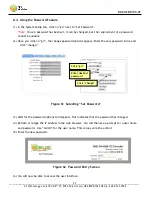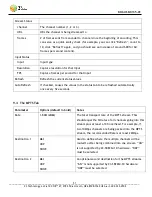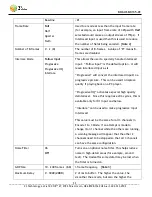
DOC-USR-0135-01
___________________________________________________________________________________________
Z3 Technology, LLC
♦
100 N 8
th
ST, STE 250
♦
Lincoln, NE 68508-1369 USA
♦
+1.402.323.0702
61
Jumbo PES
(UDP/TS Only)
None
1 AU, 2 AUs, 3 AUs, 4
AUs
This needs to be set for compliance with certain
ISDB-T decoders. Should otherwise be left as
“None”.
RTP Port
(RTP Only)
0 – 9999
(8892 – 8898)
If RTP format is selected, the port # associated with
that audio channel.
Output Setup
Output Format
RTP/RTSP
UDP
TSRTP
RTMP
TSFILE
FILE
MPTS
Output format of encoded stream.
RTP requires an SDP file for the receiver or the use
of the RTSP URL (see Section 6.6, “Streaming RTP”
on page 17 for more details).
If UDP is selected, don’t forget to check the value
of TS Rate to make sure it is in line with
expectation.
TSRTP causes streaming of TS over RTP.
See Section 6.16, “ STREAMING RTMP IN THREE
DIFFERENT RESOLUTIONS,” on page 39 for more on
using the RTMP format.
TSFILE will write audio and video to a TS file. If this
is selected, you should type the path/name of the
file in “Dest Address” (for example:
/media/sda1/example.ts to write to “example.ts”
on a drive connected to USB1). After writing a
TSFILE, the user should wait 10 seconds before
removing the USB to allow time for all buffers to
clear.
FILE will write raw .h264 and raw .aac to 2 separate
files. If this is selected, you should type the
path/name of the H.264 file in “Dest Address.” If
audio is enabled, a companion .aac file is then
created (for example, for “example.h264” a
companion file “example_0.aac” is created).
MPTS can be used to combine multiple inputs into a
single IP stream.





















